The GATOR mine system is a United States military system of air-dropped anti-tank and anti-personnel mines developed in the 1980s to be compatible with existing cluster dispensers. It is used with two dispenser systems—the Navy 230 kg (500 lb) CBU-78/B and the Air Force 450 kg (1,000 lb) CBU-89/B. Additionally the mines are used with the land- and helicopter-based Volcano mine system.
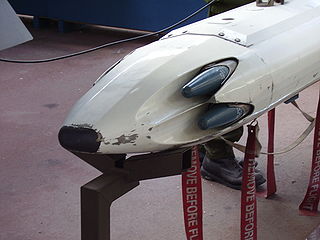
The CRV7, short for "Canadian Rocket Vehicle 7", is a 2.75-inch (70 mm) folding-fin ground attack rocket produced by Bristol Aerospace in Winnipeg, Manitoba. It was introduced in the early 1970s as an upgraded version of the standard U.S. 2.75-inch air-to-ground rockets. It was the most powerful weapon of its class, the first with enough energy to penetrate standard Warsaw Pact aircraft hangars. The CRV7 remains one of the most powerful air-to-ground attack rockets to this day, and has slowly become the de facto standard for Western-aligned forces outside the United States.
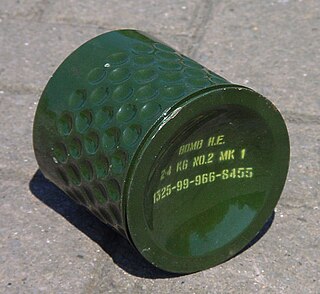
The HB 876 mine was an air dropped area denial weapon. It was used as part of the JP233 runway denial system and the 'Hades' variant of the BL755 cluster bomb. As a result of the anti-personnel mine ban it was withdrawn from British Royal Air Force service, and the last stockpiles of the mine were destroyed on 19 October 1999.

The National Development Complex (NDC) is a Pakistani defence and aerospace contractor and a division under the National Engineering and Scientific Commission (NESCOM). Founded in 1990 at the MoD, the NDC engaged in research and development in space-based missile systems and expanded its services towards developing the land-based weapons systems for the army as well as naval systems for the navy.

The AT2 mine is a scatterable anti-tank mine developed by Dynamit Nobel. It can be scattered from artillery rockets or from mine laying systems, and was used by the British, German and Norwegian armed forces until the signing of the Ottawa Treaty.
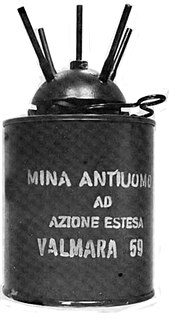
The Valmara 59 is a large cylindrical Italian bounding anti-personnel mine. It is the first in the "Valmara" family of mines produced by Valsella Meccanotecnica, and was followed by the Valmara 69 and VS-JAP. The mine's body is metal with a distinctive five-pronged head. The central prong has a hole, to allow the threading a trip wire. The inner body of the mine has a main charge surrounded with approximately 1,000 steel cubes, below which is a steel wire connecting it to the base of the mine. When the mine is triggered a small charge launches the mine into the air approximately 45 cm before the steel wire is pulled taut, the jolt of which pulls a striker into the detonator. A secondary time fuse triggers the mine after three seconds if it has not detonated after being triggered.
The Adrushy is an Indian glass-reinforced, plastic-cased anti-tank landmine.

The FFV 028 is a series of steel cased Swedish anti-tank mines that use electronic fuzes. The mines are circular, with a large Misznay Schardin effect warhead in the center of the mine, with the fuzing and sensor electronics located in the dead space above the main charge. The design of the mine dates from the 1970s and uses a magnetic influence sensor to detonate the mine, making it able to attack the full width of armoured vehicles.
The Mini MS-803 is a small South African produced Claymore type landmine. The design is very simple, with a convex brown polystyrene case containing a PE9 plastic explosive charge with three hundred 6 x 8 millimeter cylindrical steel fragments embedded into it. The mine is supported by two pairs of wire legs, which can be used to stack the mines. On the top of the mine is a small hole for inserting a detonator, which is surrounded with a PETN booster charge. The mine is normally used with an S4 electrical detonator connected to an M57 electrical firing device which is also used with the similar but larger Shrapnel mine Mk 2. The mine could also be used with MUV type pull detonators and tripwires, but after the Ottawa mine ban treaty South Africa has said that it will not use this mine with victim activated fuzes.

The HPD-1, HPD-2 and HPD-3 are a series of French electrically fuzed anti-tank landmines that use Misznay Schardin effect warheads. The entire series of mines conform to the United States MIL-STD-331.
The MI AC Disp F1 Minotaur mine is a French scatterable anti-tank mine. The mines can also be scattered from 155 millimetre artillery shells, which can hold six of the mines. The mine is cylindrical with two Misznay Schardin effect warheads, one on each side of the mine, with a 600 gram charge. The warhead is claimed to be able to penetrate 90 mm of armour at a distance of 0.5 m. It uses a magnetic influence fuze combined with an anti-handling device which arms itself 64 seconds after launch. At the end of its active life, which is set to between one and 96 hours the mine self-destructs. The land based scattering system can launch mines to a range of up to 300 m.
The M432 is a Portuguese bounding anti-personnel mine, which traces the roots of its design to the Second World War German S-mine, although it is probably more directly related to the Belgian NR 442 mine and United States M16 mine. As of 2004, all operational stocks of the mine have been destroyed, although some may have been retained for training purposes.
Selectable Lightweight Attack Munition or is a small United States multi-purpose landmine produced by ATK Precision Fuze Company in Janesville, Wisconsin from 1992-2002. It has a passive infrared sensor, and a magnetic influence sensor which allow it to be used as a demolition munition, off-route mine or full width belly attack mine.
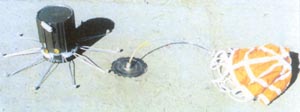
The MN-121 is a Polish scatterable anti-tank mine, externally similar to the German AT-2 mine. The mine is cylindrical with ten wire legs which fold outward to keep the mine upright. The mine uses a magnetic influence fuze, which triggers the mine when a vehicle passes over it. The mine also has an anti-handling device which triggers the mine if it is moved. The mine's warhead is a shaped charge design containing approximately 700 grams of RDX. The manufacturer claims that it is capable of penetrating 60 millimeters of armour at an offset of half a meter.
The MN-123 is a Polish scatterable anti-tank mine. The mine is a flat cylinder, with a bevelled edge. It is normally deployed from a ground vehicle, using a dispensing system holding 80 mines. The mine can also be manually laid. Like the MN-121 mine, it uses a magnetic influence fuze which detects when a vehicle passes over it. It also has an anti-handling device. Both faces of the mine have a Misznay Schardin effect shaped charge, which is reportedly able to penetrate 60 millimeters of armour at an offset of 0.3 meters.

The MPB is a Polish off-route anti-tank mine. It was developed by BELMA with its partner Military Institute of Engineer Technology. The MPB consists of a metal cylinder filled with explosives, mounted horizontally in an adjustable frame. The mine is intended to be hidden from direct view of the intended target, off to the side of a probable vehicle route, usually a road, to attack the weaker armour on the sides and rear of a vehicle. The mine can be triggered by either a contact fuze or an influence fuze based on infra-red and acoustic sensors, and is also fitted with an anti-handling device. When used with the passive infrared fuze, an acoustic sensor detects approaching vehicles and activates the infra-red sensor, which triggers the mine at an optimal moment as the target passes. The mine can be programmed to self-destruct after either 1, 10 or 30 days have passed.
The Type 84 is a Chinese air-dispersed scatterable anti-tank mine, normally deployed by the GBL212 122 mm artillery rocket, or the Type 122-15 ATML rocket for export versions. Each rocket can carry six or eight mines and has a range of around six or seven kilometres. The rockets are launched from a BM-21 Grad multiple rocket launcher system that can hold up to 24 of the rockets. A time fuse on the rocket is set before launch, which activates at a predetermined distance after firing. Upon activation, the rocket head bursts, ejecting the mines, which descend with small green parachutes that slow their fall. The mine consists of a cylindrical body with three prong legs that form a spike, which pierces the ground and arms. If the mine strikes soft ground, the spike is driven into the ground and the mine is held upright.

The Panzerwurfmine was a shaped charge hand-thrown anti-tank grenade used by Luftwaffe ground troops in World War II.
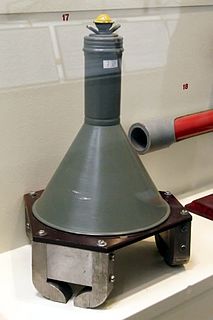
The Hafthohlladung, also known as the "Panzerknacker" was a magnetically-adhered, shaped charge anti-tank grenade used by German forces in World War II, sometimes described as a mine.

The MW-1 is a German munitions dispenser similar to the British JP233. It is designed to be carried on the Tornado IDS, although it can be carried on the F-104 Starfighter and the F-4 Phantom. The MW-1 started to be phased out after the German Government ratified the Convention on Cluster Munitions in 2009.













